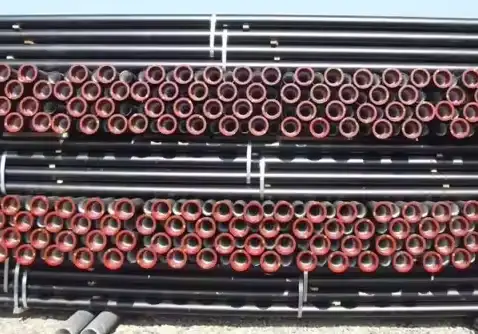Ductile iron pipes (DIPs) are the backbone of modern water and sewage systems, renowned for their strength, flexibility, and longevity. A critical aspect of their functionality lies in how they are joined—methods that ensure leak-proof, durable connections under extreme pressures and environmental conditions.

The Evolution of Ductile Iron Pipe Joining
1. From Cast Iron to Ductile Iron
-
Cast Iron Era (1800s–1950s): Bell-and-spigot joints sealed with molten lead and hemp.
-
Ductile Iron Revolution (1960s): Introduction of nodular graphite (magnesium-treated) iron, enabling flexible joints resistant to cracking.
2. Modern Joining Standards
-
ISO 2531: Global standard for push-on joints and mechanical couplings.
-
AWWA C110/C111: U.S. specifications for rubber-gasketed joints and flange adapters.
Key Joining Methods for Ductile Iron Pipes
1. Push-On Joints
-
Design: A rubber gasket compressed inside a bell-shaped socket.
-
Installation: Lubricant applied to the spigot end, then pushed into the bell.
-
Pressure Rating: Up to 350 psi (24 bar).
2. Mechanical Joints (MJ)
-
Components: Gland, follower ring, bolts, and rubber gasket.
-
Use Case: High-vibration areas (e.g., near railways).
3. Flanged Joints
-
Structure: Bolted flanges with elastomeric seals.
-
Applications: Pump stations, valve connections.
4. Restrained Joints
-
Mechanism: Locking segments or harnesses to prevent axial movement.
-
Scenarios: Sloped terrains or seismic zones.
Table 1: Comparison of Ductile Iron Pipe Joints
| Joint Type | Installation Speed | Pressure Tolerance | Cost (USD/m) | Common Applications |
|---|---|---|---|---|
| Push-On | Fast | 350 psi | 12–12–18 | Municipal water lines |
| Mechanical (MJ) | Moderate | 500 psi | 25–25–35 | Industrial plants |
| Flanged | Slow | 600 psi | 40–40–60 | Pump stations |
| Restrained | Moderate | 450 psi | 30–30–45 | Earthquake-prone regions |
The Science of Sealing: Materials and Mechanics
1. Rubber Gasket Chemistry
-
EPDM (Ethylene Propylene Diene Monomer): Resistant to UV, ozone, and temperatures from -40°F to 250°F (-40°C to 121°C).
-
SBR (Styrene-Butadiene Rubber): Cost-effective for low-pressure systems.
2. Stress Distribution
Ductile iron’s graphite nodules absorb stress, preventing crack propagation at joints. Finite Element Analysis (FEA) shows 20% lower stress concentration compared to cast iron.
3. Corrosion Protection
-
Cement Lining: NSF/ANSI 61-certified lining for potable water.
-
Polyethylene Encasement: Prevents electrochemical corrosion in acidic soils.
Global Standards and Compliance
| Region | Standard | Key Requirements |
|---|---|---|
| USA | AWWA C110/C111 | Bolt torque limits, gasket compression |
| Europe | EN 545/EN 598 | Joint tightness tests at 1.5x working pressure |
| China | GB/T 13295 | Mandatory restraint for slopes >15° |
6 Frequently Asked Questions (FAQs)
1. What is the most common joint type for water mains?
Push-on joints dominate municipal water systems due to their speed and reliability. For example, Los Angeles replaced 80% of its aging cast iron network with push-on DIPs, reducing installation time by 40%. The EPDM gasket’s memory effect ensures a tight seal even after ground settlement. However, mechanical joints are preferred in earthquake zones like Japan, where the 2011 Tohoku earthquake validated their resistance to shear forces.
2. How do ductile iron joints differ from PVC pipe connections?
PVC relies on solvent welding or threaded joints, which degrade under UV exposure and thermal cycling. Ductile iron’s push-on joints, conversely, maintain integrity at extreme temperatures. A 2022 study by the American Water Works Association (AWWA) found DIP joints leak 70% less than PVC in systems over 50 psi. However, PVC’s lightweight nature makes it cheaper for low-pressure rural systems.
3. What is the lifespan of a ductile iron pipe joint?
Properly installed joints last 80–100 years. In 2018, a Parisian sewer joint from 1920 was excavated and found fully functional, with EPDM-equivalent linen gaskets intact. Factors affecting longevity include:
-
Soil pH: Acidic soils (pH <5) require polyethylene wrapping.
-
Traffic Load: ASTM A796 mandates thicker pipes under highways.
-
Maintenance: Jet cleaning every 5–10 years prevents grit-induced gasket wear.
4. Can ductile iron joints handle thermal expansion?
Yes. Ductile iron’s thermal expansion coefficient (10.8 µm/m·K) is lower than steel, minimizing joint stress. For example, Dubai’s 50°C (122°F) temperature swings cause only 2 mm of linear expansion in a 6-meter DIP section, easily absorbed by the rubber gasket’s elasticity. In contrast, unrestrained PVC joints can separate under similar conditions.
5. What tools are needed to install ductile iron joints?
-
Lubricant: FDA-approved silicone grease for potable systems.
-
Pipe Puller: Hydraulic device for aligning large-diameter pipes.
-
Torque Wrench: For mechanical joint bolts (AWWA specifies 75–150 ft-lb).
-
Leak Detector: Helium-injection testing for critical systems.
In Germany, robotic installers (e.g., KARO) automate joint assembly, achieving 99% precision in gasket placement.
6. Are ductile iron joints eco-friendly?
Ductile iron is 100% recyclable, with 40% of global production using recycled scrap. Modern joints eliminate lead-based seals, reducing environmental toxicity. A 2021 lifecycle assessment showed DIP systems have 30% lower carbon footprints than HDPE over 50 years due to reduced replacement frequency.
References:
- Ductile Iron Pipe – Wikipedia
- American Water Works Association (AWWA) Standards C110 & C111 for Ductile Iron Pipe Joints
- ISO 2531: Ductile Iron Pipes, Fittings, Accessories, and Their Joints for Water Applications
- EN 545: Ductile Iron Pipes, Fittings, and Accessories – Requirements and Tests
- U.S. Environmental Protection Agency (EPA) – Water Infrastructure Research and Standards
